In this thread you can see several things how I do it:
- a buildalong of a hollow limb design bow
- how to make a take down sleeve and how to attach it
- how to make a integrated horn wedge to stiffen up the tips
- how to make a sinew/rawhide nock
HLD = hollow limb design bow. Several spezimen are listed in the ‘bow’ category. An explanation and some thoughts about HLD will follow.
Now lets start, here are the tools needed:

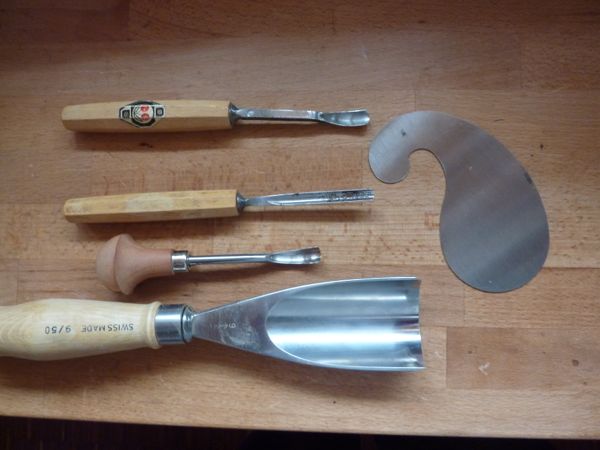
Hollow limb design only makes sense on high crown staves.
I have choosen a Laburnum (golden chain tree) stave, about 2,5 – 3“ in diameter and 66“ long.
After debarking I saw this would be not an easy candidate, very wavy and lots of knots. I run it through the bandsaw and this is what I have at the moment:
Side profile

front profile



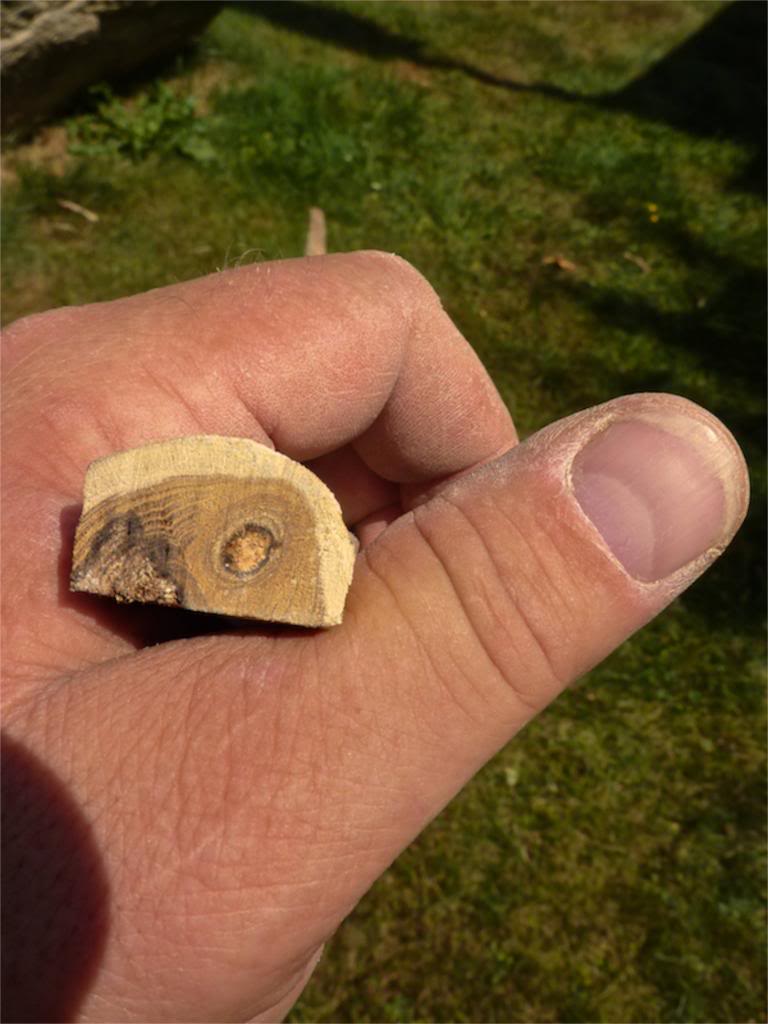
here you see the fungus inside the stave, some of the outer rings are intact, but the fungus did spread over the rings …..


My first thought: let it be firewood!!!
But anyway, it doesn’t matter if this will became a bow or not – showing the process of hollow limb can be done on every piece of wood. Let’s try it and don’t expect a shootable bow …
This are the disadvantages:
– very thin ringed
– not matching string alignment
– massive dogleg in one limb
– not matching reflex of the limbs
– severtal knots (not avoidable in layout)
– some holes
– a fungus inside, growing from the center pith outwards, but was not intelligent enough to do that growing in the same ring
This are the advantages:
– nearly no twist
– it’s laburnum – one of the prettiest woods
– it’s laburnum – one of the best bowwoods
– and it has everything what we call character – so it’s a challange
the fungus has produced that bright spongy material, nearby is a dark brown which I think the tree has produced to stop the fungus – this is very hard and brittle (inlayed minerals?) and makes the tools quickly dull. The olive is the origin color of the heartwood, the white is the sap – this is the good stuff


on this little stave I can use mostly only the gooseneck scraper and the bent gauge

the result so far

I think the advantages of the hollow limb design are: It will add additional strength to the bow, without more wood (fold a sheet of paper like the letter U – and it is stiff!). Will say it is mass saving. And, the flattening out alone will create a movement in the limbs. Much less wood and much less stress. The compression stress concentrates in the ‘bellywalls’ (at braceheight), while drawing the bow the hollow limb flattens out, the neutral plane changes and the stress is contributed in a wider area the longer the draw. In other words the hollow limb design affects a much higher drawweight than a ‘normal’ designed bow (steeper f/d curve in the first inches of draw) I think this is a difference to ACS glass bows, the hollowed out there isn’t that high and because it is a stiff laminated glass bow it cannot play with the flattening out advantage. The rounded shape of an ACS design saves mass and gets stiffer (sideways). This is good – but I’m talking about very deep hollowed out dynamic limbs!
This stave is by far not the best candidate to show the advantages of the hollow limb design, but it’s an interesting challenge and the beginning is already done.
I do the hollow limb design normally only the best intact staves, so it is quite easy to chase an inner ring and follow outwards to the tip as a guideline. Usually I have then little work to do the taper outwards.
Not so here! The fungus has spread over the rings and destroyed the wood. I have to take off the complete bright spongy stuff, even if it ‘hurts’ an inner ring. This can cause stability problems (warping sidewards) or coming out of tiller, but I have to live with that. If one of the two belly walls gets too thin , it will be overstressed. I have to compensate that with slightly more thickness in the rounded middle.
A first floor tiller test shows heavy warping, as expected. To get that a bit better I cut off 2“ from the lower limb which has a heavy curve sidewards.

Cut of 2” from the upper limb also.
Didn’t get enough for string alignment, heating is nessecary – we that later!
For now continue hollowing out the limbs
here two pics of cutting in intact wood, results in nice long chips.


after working with the ent gauge:

after working with the gooseneck:

working out knots and holes to nearly the same thickness as the surrounding area:


here is a pic how it looks now:
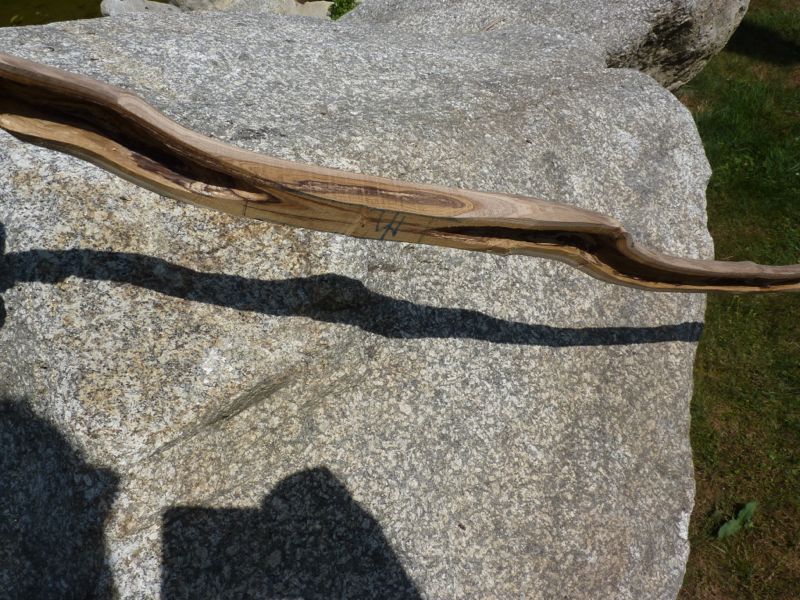
here is a grain wave on one of the belly walls (problem again):

the same spot:

such areas must be carefully watched, hope I can take off wood here while tillering
marking thick spots and working down:



enough for today, here is the leftover of the second session (just the same amount as the from the first):

Probably not every wood can withstand a HLD (is to be checked out). I have done it (ok, a mild version) even with hazel (not good in compression) with very good result. My thoughts on this point: at brace you will have a given thickness of the bow limb (measured from the crown to the belly walls). What happens when you draw the bow? The hollow limbs flattens out, the thickness of the limbs are now less than at brace. It’s like drawing another bow, one with thinner, but wider limbs. This affects a comfortable draw, the increase in the f/d isn’t that high than normal and, main point, that thinner limbs creates lower stress on back and belly.
The optimum is probably when we can create a limb design that can match the horizontal and the vertical forces at a specific drawweight. Will say, a good bow is built near the break. Hollow limb design should do the same also with horizontal forces, the flattening out should be that much as possible.Here is a quick sketch to make it a bit clearer.

Now let’s go on:
I have marked some areas in red where wood is to be scraped off. I have meanwhile mostly changed over from the bent gauge to the gooseneck. I control thickness with my fingers, but have to react every inch on other problems – this stave is really an adventure!
Upper limb

lower limb

near fade, heavy destroyed wood ….

working out knots/holes

knot/dead branch near fade

also fine correcting side taper

I did some floortiller, I can bend that thing to a straight line (all the amount of reflex). Sorry no pic, would need an assistant. Two things are evident: first the stave tends to warp to the right (seen from archer, upside up) – so need to bend in the handle section to the left side; and second floortiller shows a much more stiffer lower limb (that one with the dogleg) – so needs to be scraped down and reduce the too high reflex.
Let’s begin with the last, reducing reflex. I will do that in two portions, one at the dogleg and then one near the fade.
That dogleg in the lower limb causes most of the uneven reflex in the limbs. I will try to heat it out a bit to bring the side profile more in line
here is a sketch what I want to do

now here is the heating setup

For heat bending I use paraffin oil (cheap at Ikea). It damps (and stinks!), when the temperature gets too high. Good control mechanism.
The stave is clamped in the vice and secured with an additional clamp (left from vice). As weight I use a canister, bound on the stave. Of course this done before heating. Now measure the distance to the floor. As you see, I have a plastic clamp on the tip and a ruler leant upon. With this setup I can easily control the bending process, without interrupt the heating up.
Another good trick is an old can with a cutting lengthwise, this allows the heat going round the whole limb. It is held in place with pliers, simple and super effective!



I got the tip moving about 3” to the string. That is good, but not enough. Take a look at the pic, handle is still not parallel to my bench (both tips are laying on the edge of my bench). I leave it for now at it is; perhaps I will give it later another try.
Aren’t that beautiful colors on the oiled sections? That’s why I like that wood so much.
Now is time to bring the string in line. The string is about 1,5” off.

Noticed the handle is heavily damaged by the fungus, more than I thought. Problem here: It should be stiff and I need to heat bend the stave here for string alignment. I will do that with a longer run and less heat than normal. Perhaps we will need additional reinforcement here, that should be a matter for later.
This way it is clamped in the vice, notice the melting glue stick for preventing damage on the limb

how the can is held in place while heating

I heated down the 1,5” offset carefully with low heat (way lower than I normally do).
After cooling down, I saw that fret ( see earlier pics) on the handle had opened a bit. Well, I have expected it and it happened. No nerves for now to get on, will think over a repair. Any suggestions?

the leftover from session 3

Let’s continue with floor tiller, session 4:
I don’t like the usual floortillering method very much, because you look on at a steep angle to the limbs. It is a lot better not to look directly, but via a large mirror placed some yards away. This allows watching in a more rectangular (word?) way.
I found another way to do the ‘floortiller’, not on the floor but horizontally.




In the pics above you can see my method of tillering in my vice via leather shoes + cord.
This works well for me, I can immediately react on the stiff points and take off wood with the scraper. This allows fast working, no need for taking off and on the ‘string’ just open the vice and pull horizontally. The cord hangs always in the vice.
Pulling the stave with one hand I lay my other over every inch of the limbs belly sides. I can feel the bending and can feel also how the hollow limb flattens out. It do that even over the whole bending limb.Scraping with the gooseneck and using the thumb as a guideline to get even thickness:
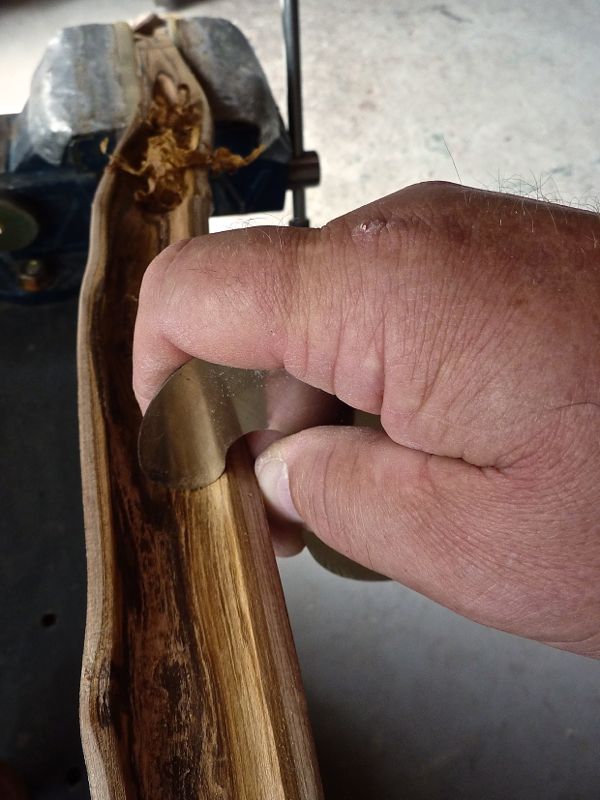
This process is done several times, until I get the limbs bending so far enough for long string tillering. And of course the limbs should bend simultaneous.
carefully woking at the nocks with sanding linen:

Btw, I don’t like rasps that much, you don’t feel the grain! I like thick and sharp scrapers, they take off wood excessive without leaving marks and goes with the grain over the humps and bumps. A rasp is a good choice to plane knotty areas, esp. when knots have really hard old or dead wood in them.
This is a good trick for sanding in the grooves over humps. It is a flexible melting stick wrapped in a sanding net:
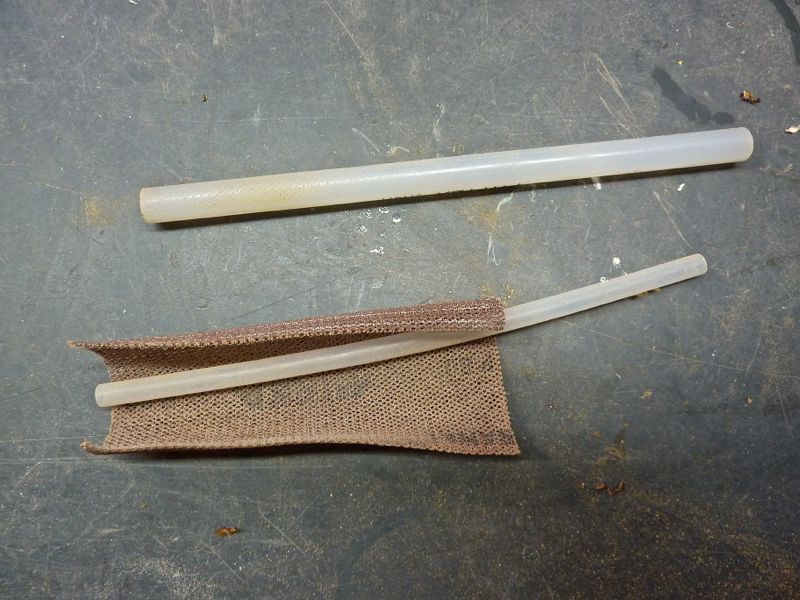


Here is the leftover from the 4 session

session 5: the handle repair
Finally I decided to do the repair on the handle. My first thought: soak it in super glue and wrap the handle with strong hemp cord. But that crack made me nervous, so I split off the half of the belly to examine how it looks. Catastrophe!



A miracle it stayed together while floortiller and long string tillering. Big damage here, the fungus has made a tunnel of spongy white stuff. Only millimeters of the intact side walls are left, this affords a strong repair.

So what to do?
Next idea: Sand it down and glue on a new piece off intact wood. Thinking over this, I wondered if a take down sleeve would add strength in that area.
We will never know if we don’t try!

making take down bows from billets is ok, but cutting through afull length stave always makes me crazy …. but in this case probably the best

a take down sleeve was quick made out of junk and the two halves a bit carved to get the sleeves on

The sleeve ends of the limbs need a good strengthening. Fortunately I found a matching piece of golden chain tree in my fire wood.

Next step sand down as much as possible to intact wood and glue on a piece of wood in the handle/fade area.
Marking the new ‘fade overlays’ and cutting out
this are the parts I have now:

Glueing on the new fades:

After a dry mounting I felt again warping sideways. To get that matched, I have to glue on the sleeves a bit out of the line. I will glue on the sleeves separately for most safety, I hope the string is then in line. I want to avoid heating again, when possible. Using very thin Epoxi, filling the grooves and valleys is no problem.





It seems like it does work. We will see. The glued on pieces are looking very ugly, let’s bring them in a nicer shape. First cut off the excess with the hacksaw, then rasping and rough sanding.




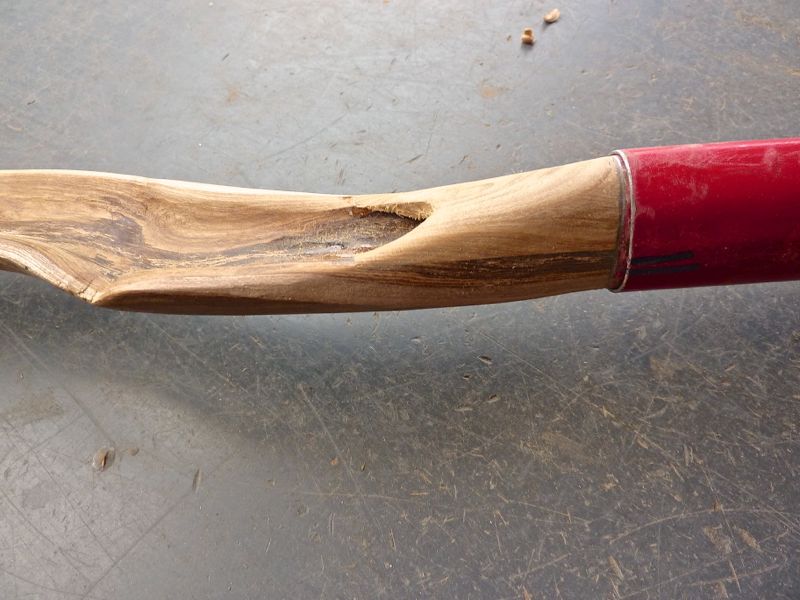




Now is the time for more tillering, and cutting the bow to its final length. I go for an asymmetrical, top limb is about 2” longer. I have to decide the final upper and lower limb
I will do the tips soon to get her braced, any suggestions for the tip design? Overlays, pin, self, wrapping, …?
Here is the leftover from session 5 with the cut offs from the glued on pieces

I’ll continue in a few days, upcoming decisions are:
1. symmetrical or asymmetrical bow
2. design of tips (overlay, pin, self, wrapping, …)
BTW.
this is from what the sleeve is made of. It’s a tool called ‘dritte Hand’ (in German which means translated word by word ‘a third hand’ don’t know if the title contra choc is the English word or just a phantasy product.


The two pipes fit perfectly

This tool is used to install things like boards or plywood to a ceiling. I have two of that and both are junk, because the d……d plastic grip broke of. Now they are laying in the box for metal trash and are waiting for a new birth as t/d sleeves.
Session 6: Tips
Some guys requested some time ago a buildalong horn insert (wedge) tips. So let’s do it here!
We need two matching wedges, I have a bunch of them prepared from brown black and colored horn. First make two rectangular pieces of the desired thickness (about 3mm is ok).

Next sand down to a wedge, tapering to zero on one end



I use a handy belt sander for this job. Use little wood boards to press the horn down, otherwise you sand your fingers flat (I made this experience!).
Be sure the pieces are matching.
Now the slot in the tip:
Camp the bow in the vice and mark vertically where to cut and horizontally how far to cut, be sure both tips were matching.

Cut the slots in the tip ends, I use a sharp Japanese hacksaw.

this how it looks after the first cut – now comes the tricky part:
clamp the tip end with a plastic clamp and saw again just in the same slot as you did the first time

The cut should go exact to the end of the slot. Now pull out the saw blade and the clamp closes the slot. Repeat the procedure, next use a second clamp:

and voila’ here is the result like a miracle we have a v-slot in the tips, exactly were we want it

The horn wedges should slip in with little pressure, you could use the wife’s nail file to get the surface even (when needed)

Before glueing try a dry run, here is how it should look like:



Now glue in the wedges, I have used super glue, TB3 and Epoxi successfully.
For now I go with epoxi. I wet all surfaces – the slot and the wedge
Wait til the glue gets a bit sticky, to prevent squeezing out when clamping.


I use office metal clamps, I like them for little glue-ups.
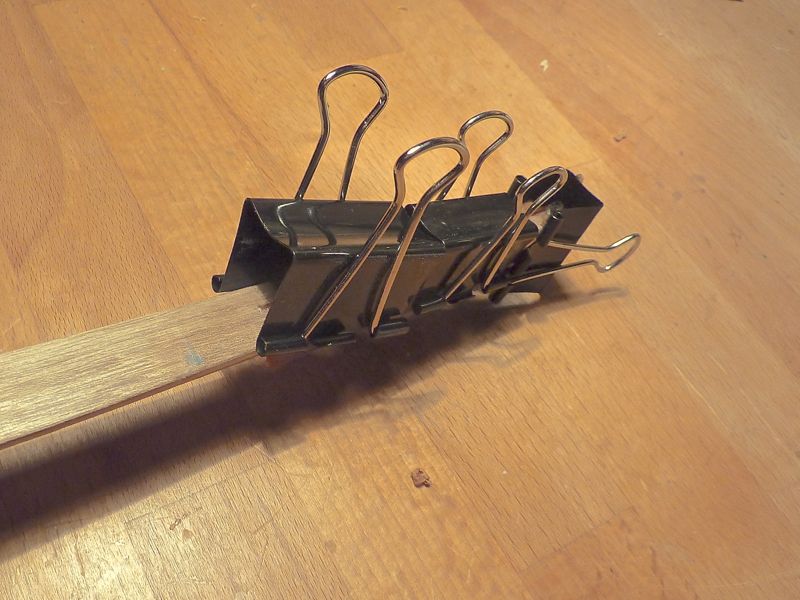

After the glue has cured:
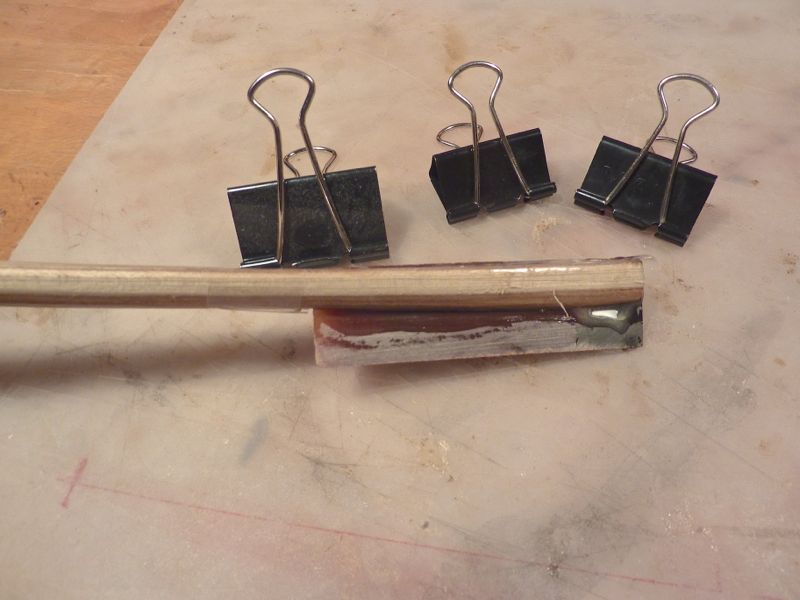
Cut off excess, sand down to the limbs surface.

After sanding:

And more sanding:
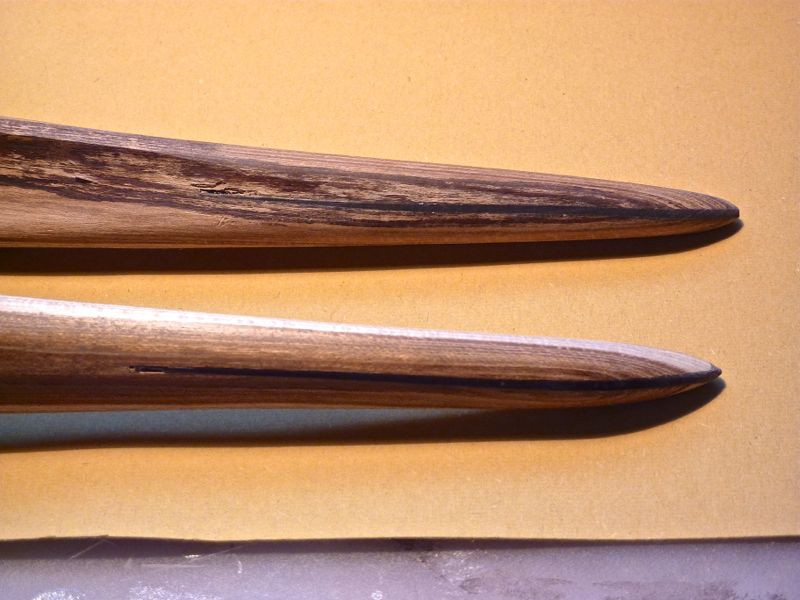


from the side:

I will go for sinew wrapped tips (sorry ssgtchad), therefore I have sanded the tips more roundish.
Wetting sinew and strips of rawhide:
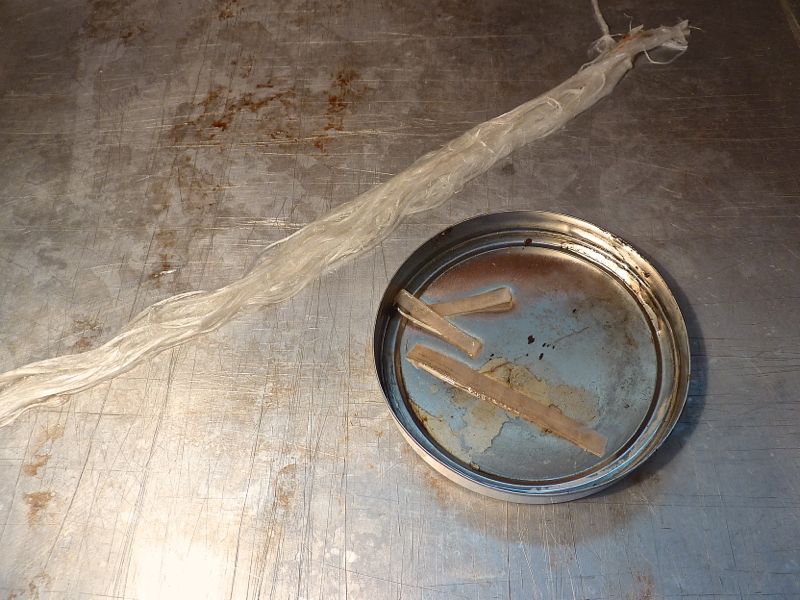
Taping the tips and applying hide glue:

This is what I will do, forming a rucksack using raw hide and hide glue:


The first round sinew wrap:

Fold back the strip, second sinew wrap, cut off excess strip:

When the glue isn’t sticky, wrap the complete tip with rubber textile to press the sinew in place. (sorry forgot the pic)
The day after the sinew has a bit dried out, after a first sanding it looks like this:



Now we have to wait a few days for complete curing.
I have begun with tillering and realized a big problem: the fungus damaged areas are incalculable!
The hold one time and a second later here is a big let off. If I couldn’t manage this, I see only one way: scrape off all the fungus portions and go for a light weight bow. We will see …
Session 7: The End
Finally found the nerves to continue. As said I scraped of nearly all of the fungus destroyed portions. It was impossible (at least for me) to tiller with this damaged wood. The result is now a bow with very thin limbs 6 – 8 mm. This will become only a light weight bow, but better as no bow.
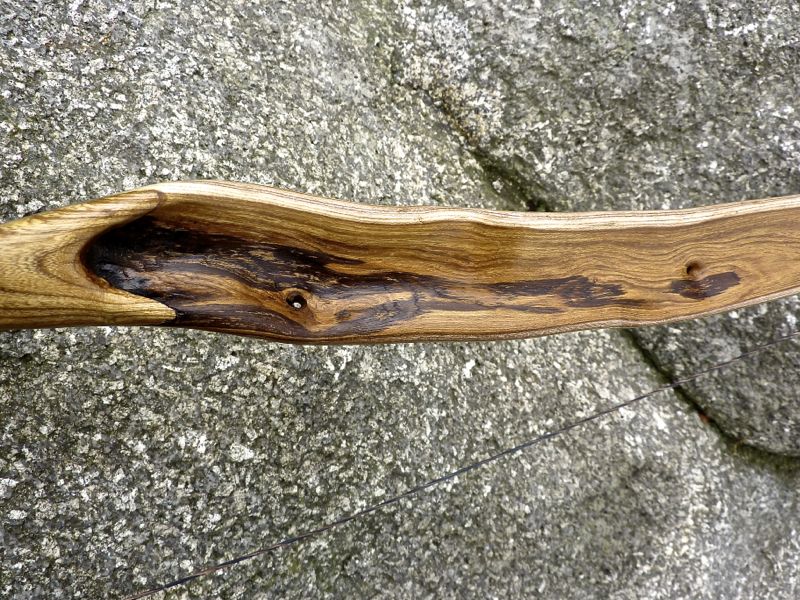

I worked around the holes carefully, here are pics from belly/back




Ok, the bow was tillered to braceheight and a few inches of draw. It didn’t feel good, a kinda wobbly. Therefore I decided to cut off the lower tip and make the symmetrical into an asymmetrical bow. (I should have better worked with temporary tips).


So I had to do the inlay wedge once more (waiting again until the glue cures). Didn’t want to wait once more for sinew wrap curing, so I filed in some normal kerfs.
The handle is already done with a two tone leather to hide the ugly sleeves. The grip is a bit upholstered for matching better with the lines of the bow.



Usually I don’t use the tillertree often, except making drawweight measurements. But it is good to get a free hand for the camera.
Have you noticed my cradle? It is a nylon strap (from an old safety belt), this allows the bow to balance out.
On the wall is a sketch paper taped, you can see the increase of bend. This allows to control the limb working the whole length.
The uneven reflex causes a non string parallel handle, I will live with that – don’t want a heat on the bow again
after a lot of scaping here and there and some sanding and some polishing and some oiling …
This was a hard struggle from firewood to a bow!
Long lasting story, but now we are
READY!!!
You can find the finished bow
here!




















































 In the pics above you can see my method of tillering in my vice via leather shoes + cord.
In the pics above you can see my method of tillering in my vice via leather shoes + cord.
































































 I worked around the holes carefully, here are pics from belly/back
I worked around the holes carefully, here are pics from belly/back


 Ok, the bow was tillered to braceheight and a few inches of draw. It didn’t feel good, a kinda wobbly. Therefore I decided to cut off the lower tip and make the symmetrical into an asymmetrical bow. (I should have better worked with temporary tips).
Ok, the bow was tillered to braceheight and a few inches of draw. It didn’t feel good, a kinda wobbly. Therefore I decided to cut off the lower tip and make the symmetrical into an asymmetrical bow. (I should have better worked with temporary tips).








5 Comments
Your blog is awesome! Thanks for posting such good details about your methods.
Wow, that was amazing. Awesome work! I would have lost my nerve more than once.
Thank you Stephen, I have started this buildalong on the primitive archer forum and there was no way out. But you were right it made me nervous too.
Dear Simon, I have written to you before, but have had a rest from making bows. Recently I have started again and am thinking about having another go at a HLD bow. I am considering using some Sorbus aucuparia /mountain ash. What do you think, will that work? I am also very interested in your use of horn to stiffen tips – do you think that one could use bone in the same fashion? Anyway your work here on primitive bows leaves me speechless and forever thankful. You are a in my opinion one of the best bowyers, if you brake a bow smile and let me know then I won’t feel so bad. All the best Peter
Hi Peter, nice to hear again from you! First, please excuse my late response – I was offline for some days.
Best woods for HLD are species with interlocking grain, such as many sorts of elm. I have made lots of HLD out of many different woods, but none out of sorbus aucuparia. This wood often grows very straight with an even crown, which is good for this design. Search for staves with 2-3″ in diameter.
Stiffening tips with wedges: I think horn is the better candidate, because it is lighter and has an oriented structure (like a grain).
Hope that helps. Many thanks for your nice compliments! And yes I have broken many bows, sometimes a stick just dunno want to be a bow …
Have fun with your projects!
Simon